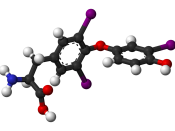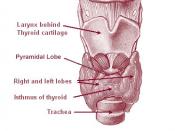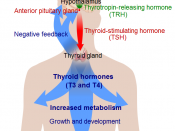PAGE 6
Hypothyroidism
The thyroid gland is a small endocrine gland, measuring about 2 inches, which is located in front of the neck, below the larynx. It wraps round the trachea, with the two lobes of the gland being connected by a band of tissue, called the isthmus. The thyroid is made up of small globular sacs, largely composed of follicular cells, which contain the iodine-rich protein thyroglobulin. The hormones thyroxine (T4) and triiodothyronine (T3) are synthesized within the structure of thyroglobulin, which also serves as the storage form of the hormones. The thyroid tissue also has a smaller number of parafollicular cells, which secrete the hormone calcitonin. The thyroid hormones regulate the growth, development and the speed of metabolism of every cell in the body. T3 and T4 stimulate the cell tissue to produce proteins which increase the basal metabolic rate. They control the rate at which the body converts oxygen and calories to energy.
Normal levels of T4 and T3 ensure the normal development of the brain and normal growth in childhood. The thyroid hormones also regulate heart rate, increase cardiac contractility and output, and affect the functioning of the central nervous system and the reproductive system. Calcitonin regulates the calcium in the blood stream. The synthesis and release of thyroid hormones is regulated by the thyrotropin-releasing hormone from the hypothalamus and the thyroid stimulating hormone from the pituitary gland. Thyroid hormones are also affected by the amount of iodine consumed and the total caloric intake in the diet. Hypothyroidism, or Myxedema, is the most common disease of the thyroid gland and occurs when the gland becomes underactive, resulting in deficient production of the thyroid hormones (Braverman, 2000).
The incidence of Hypothyroidism is fairly widespread. Although the disease affects both sexes and all ages, women are about five...


